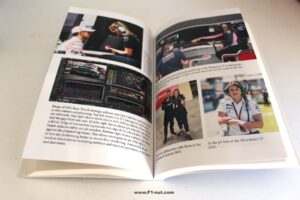
New Book Review: How to Win a Grand Prix by Bernie Collins
Positives
Negatives
During the Singapore GP it was interesting to see how various strategy decisions for certain teams played a big part in the results – Lewis and Danny Ric with the obvious wrong soft tyre call to start the race.
There are F1 books that have covered the strategy aspects of F1 but Bernie Collins’ new book “How to Win A Grand Prix” is the only one that comes to mind that comes from a race engineer’s and strategy engineers perspective.
Fans who watch Sky UK’s F1 racing broadcast will have seen pundit Bernie Collins this year providing strategy commentary at various GP races having herself been a engineer with McLaren, Force India and lastly Aston Martin’s chief race strategist alongside drivers like Checo Perez, Sebastian Vettel and Jenson Button.
Drawing on her early career experience as an engineer, the early chapters help the reader understand the different engineering departments within a team, the use of the simulator, the role of each team’s remote ‘mission control’ and even the personal challenges of managing constant international travel to races.
From Chapter 9 onwards, Bernie covers the F1 season from the engineers perspective – preparations in the off-season, winter testing program and issues, trackside and tyre modelling.
There are chapters dedicated to each key session of the race weekend including Free Practice 1, FP2, FP3, Qualifying, Post-qualifying, Race start, final laps and post race debriefs. It quickly becomes apparent that predicting tyre performance and weather are very key skills for a race strategist.
The chapters on FP1, FP2 and FP3 are particularly insightful as they really help make sense of what teams are trying to achieve with their run plans for each specific practice session. During the Singapore GP, I was flicking back to these chapters to see what the teams were likely doing and interpret some of the lap times.
I found Bernie’s commentary in her book (written by longtime F1 author Maurice Hamilton) as very conversational – exactly how she comes across on TV. Aside from the technical content, there are also chapters reflecting on the personal demands of job.
The content though still assumes a fair degree of familiarity with F1 though, so this book is better suited to knowledgeable F1 fans rather than newbies. For young or budding engineers that are keen on understanding the sport – I think this is a very handy book!
Wow Factor/Money shot:Explaining run programs in free practice sessions, reading race trace charts, behind the scenes in Sergio Perez/Force India’s maiden win in the 2020 Bahrain GP.
Suitable for: Technically inclined F1 fans and aspiring F1 engineers
Amazon.com link: click here









